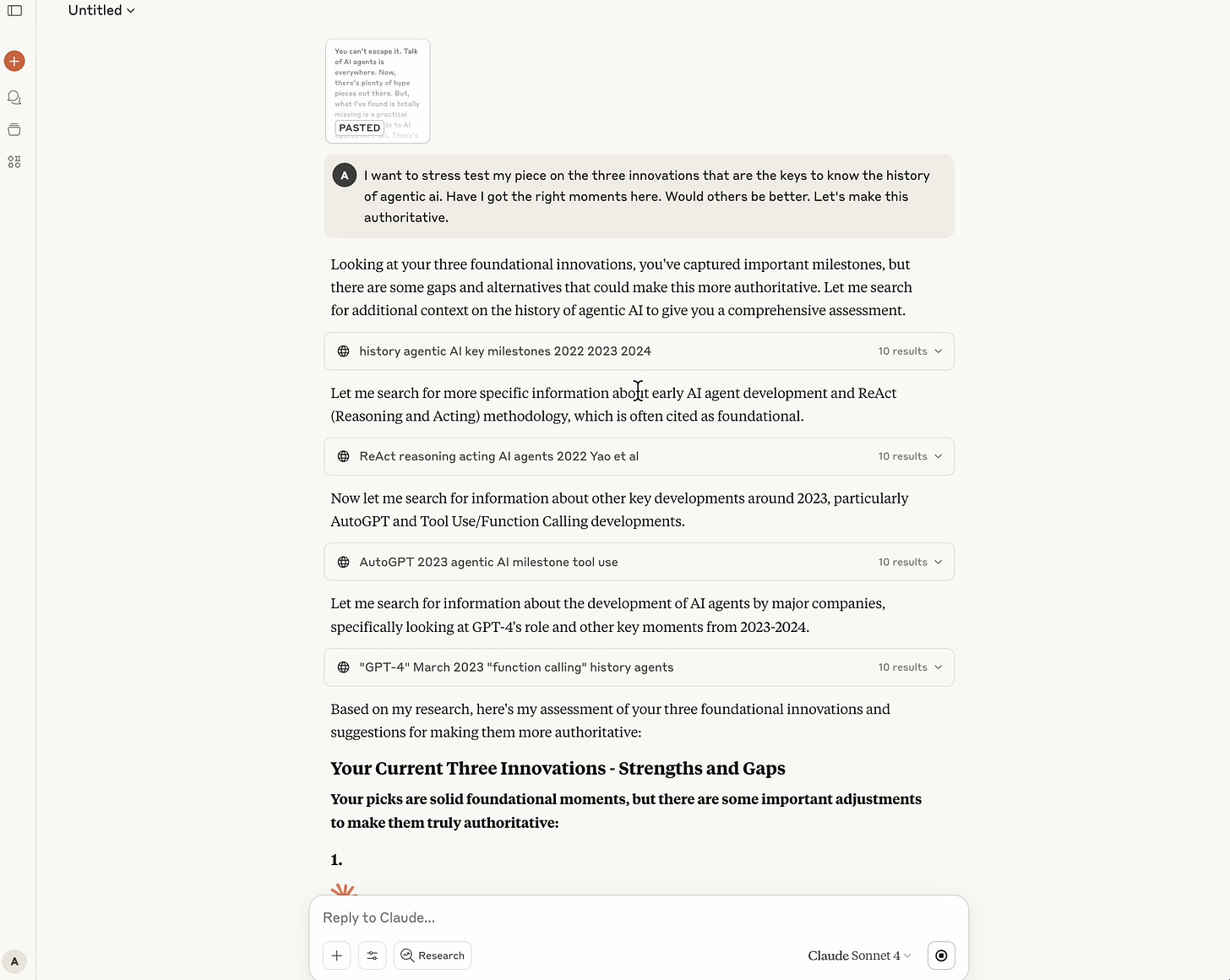AI Agents: The Ultimate Guide for PMs
Taking you from 0 to 1 without the hype
You can’t escape it. Talk of AI agents is everywhere.
You’ve already seen plenty of hype pieces. But, what I’ve found is totally missing is a practical and simple guide to AI agents.
Today’s Post
So I teamed up with Vikash Rungta - an AI PM at Meta, who teaches GenAI at Stanford Continuing Studies.
We’re bringing you the web’s first practical and simple guide to AI Agents for PMs:
The 3 Key Foundations of Agentic AI
How to Use Consumer Agents for Product Managers
The Top 5 AI Agents to Build & Use as a PM: Step-by-Step
What You Need to Know to Build AI Agents Into Your Product
1. The 3 Foundations of Agentic AI
We want to start from the first principles: LLMs vs Agents, the history of agentic AI, and a taxonomy of the Agent tools out there.
Foundation One - LLMs vs Agents
You know LLMs already. So what are agents? We’re shifting from building oracles to building workers:
Think of it this way:
You ask an LLM: "What are the steps to book a flight from SFO to JFK for next Tuesday?"
You tell an Agent: "Book me the cheapest direct flight from SFO to JFK for next Tuesday."
Foundation Two - The History of Agentic AI
So how did we get here? 6 key innovations over 24 months:
October 2022
2 very important things happened:
Google researchers released the ReAct framework, which’s principle of a Reason → Act → Observe cycle became the basis for Agents today
LangChain was released, which solved the practical problem of: how do we connect LLMs to the real world?
These innovations transformed LLMs from brilliant “brains in a jar” into systems that could query databases, call APIs, and remember conversations.
November 2022
ChatGPT launched - leading to a meteoric rise in the amount of interest in LLMs. (As a result, LangChain and ReAct blew up.)
March 2023
GPT-4 launched. It was a game changer.
GPT-3.5 agents were mostly broken. They would get stuck in loops, make logical errors, and ignore instructions. GPT-4 agents suddenly could follow complex multi-step plans without going off the rails.
As a result, two weeks after GPT-4’s launch, AutoGPT went viral and hit 100,000 GitHub stars. That’s when the world realized AI wasn’t just about chatbots anymore.
June 2023
OpenAI had been watching developers hack together agent functionality with frameworks for months. So they finally released function calling to make it native.
Now models could directly output structured JSON to call external functions:
{
"function_name": "send_email",
"arguments": {"to": "john@acme.com", "subject": "Meeting confirmed"}
}Any API could become a "tool,” and the era of native agent support began.
November 2024
But success created chaos. Every tool needed custom integration with every model. Companies faced building hundreds of brittle connections: the "integration tax."
Anthropic released Model Context Protocol, which became the "USB-C for AI." It solved the integration tax. Tool providers like Gong or Salesforce could integrate once, and then agent can could use them instantly.
6 Innovations → AI Agents
In just 24 months, AI went from answering questions to running autonomous workflows:
ReAct gave us the architecture
LangChain built the infrastructure
GPT-4 provided the intelligence
AutoGPT proved it worked
Function Calling made it native
MCP standardized everything
That’s how we’ve gotten to AI agents taking over LinkedIn.
Foundation Three - Taxonomy of AI Agent Tooling Out There
There’s been an explosion of AI agents out there.
If you’ve used Claude or Grok recently, you’ve probably noticed an agent is built in!

ChatGPT is also rolling out its own agent as we speak (more on that in section 3). Then there’s all the tools you see, like n8n, or Cursor’s agent, or Lovable…
How should you think about what these tools are and what each can do?
Most of the taxonomies we’ve seen out there are unnecessarily complex. Think of it as 4 main categories:
Category 1 - Consumer Agents (Built-In)
Most Prominent Examples: ChatGPT Agent, Claude 4, Grok, Gemini 4
The latest versions of LLMs have AI agents built in. They’re best for quick tasks, research, and creating content (like PRDs or Strategy Docs).
Category 2 - No-Code Agent Builders
Examples: Zapier Agents, Lindy, Relay.app, Make.com, n8n
Think Zapier, but with an AI brain making decisions. You drag and drop workflows, and the LLM handles the smart parts. Perfect for automating email triage, generating reports, or monitoring competitors.
Category 3 - Developer-First Platforms
Most Prominent Examples: LangChain, CrewAI, AutoGen, Swarm
The power tools for engineering teams to build custom agents from scratch. Use these when you're building customer-facing agent features or need deep integration with your product's systems.
Category 4 - Specialized Agent Apps
Most Prominent Examples: Cursor (coding), Lovable (prototyping), Perplexity (research), Notion AI (writing), Otter.ai (meetings)
Purpose-built agents that excel at one specific job-to-be-done. They don't just automate—they augment. Once you experience Cursor coding with full project context, regular VS Code feels broken.
When to use which
Here’s the decision tree for PMs:
Need something quick? → Consumer Agents
Want to automate workflows? → No-Code Builders
Building a product feature? → That’s Developer-First
Have a specific job-to-be-done? → Find a Specialized App
We’ll now go in depth on using category 1 in section 2 and category 2 in section 3.
2. How to Use Consumer Agents for Product Managers
The most common AI agent that everyone’s going to get exposure to is ChatGPT’s. You may not have access yet (rolling out as we speak), but it’s coming to your tool window soon:
Basically, it allows ChatGPT to use a browser and browse websites. You can even take over control to help it login to systems for you.
How should you use it and similar tools in Category 1 (eg, Claude, Manus, Grok)?
Use them for tasks like:
Updating your spreadsheet with some manual data pulled from a report
Browsing a website and ordering the right things for you
Creating a plan for you like based on your context
Combing through voluminous data to produce a synthesis
Sending connection requests to beta users with personalized messages
On the other hand, avoid them for things like:
Creating your final presentation - they’re better at drafts
Anything related to calendars - these foil them
Doing an analysis and a presentation - they fail in these longer tasks
Anything to do with Captcha - they get foiled by them
Doing things that take 5 minutes manually - often, agents will take longer or fail
Here’s the video evidence of me demoing all of that.
These tools will get better. But right now they have some very real limitations.
To solve harder agent use cases, you need to build your own.
3. The Top 5 AI Agents to Build to Improve Your PM Work
As a PM, you should be making your own AI agents in no-code tools.
We are going to demo one each in the 5 most popular tools: Zapier, n8n, Make.com, Lindy, and Relay.app.
From our extensive testing, the 5 best to create are:
Keep reading with a 7-day free trial
Subscribe to Product Growth to keep reading this post and get 7 days of free access to the full post archives.



